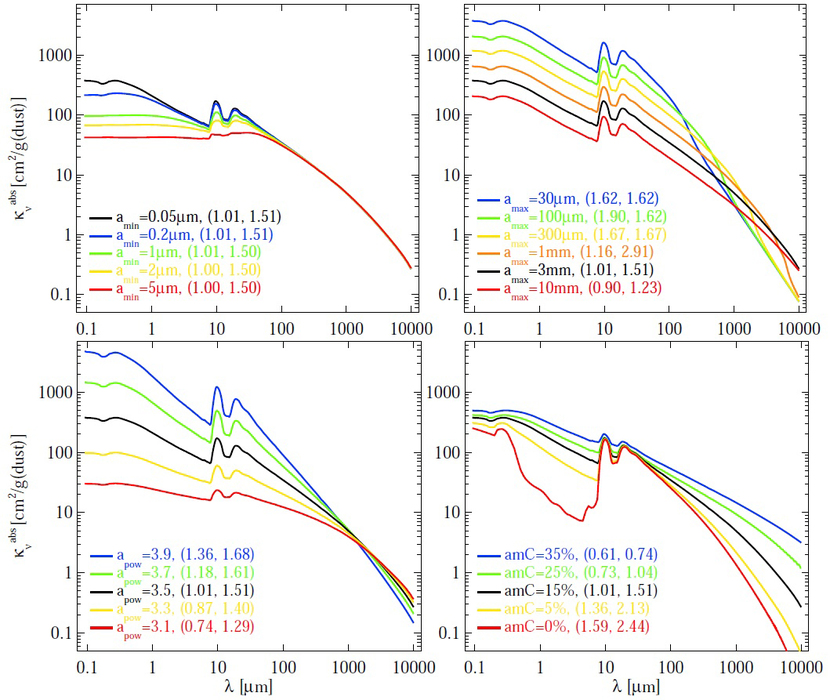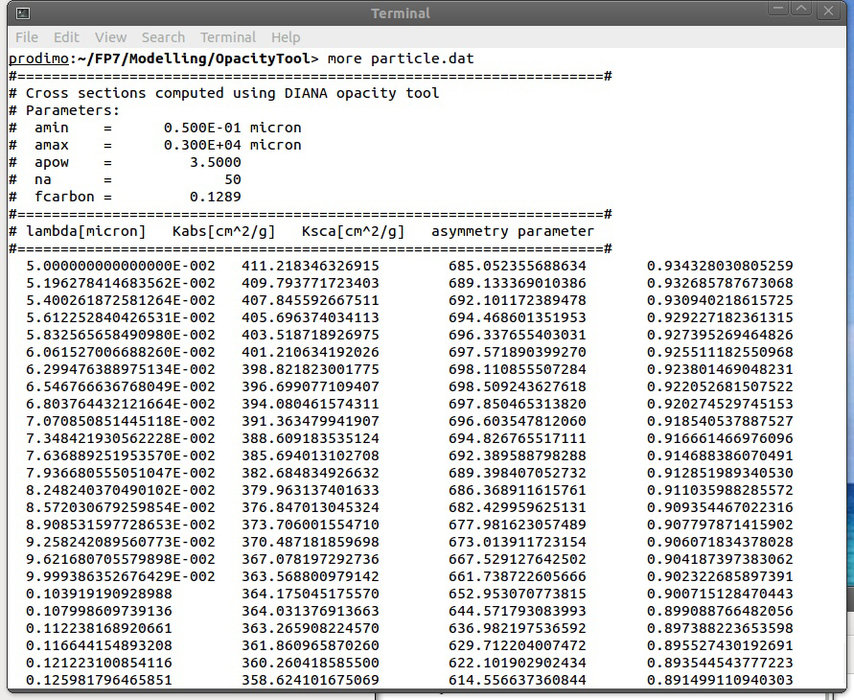Fortran package to compute DIANA standard dust opacities
Dust opacities have a crucial influence on the disk modelling results, not only with regard to the predicted continuum observations, but also for chemistry and emission lines. We have therefore developed a new standard approach to compute dust opacities for the purpose of disc modelling (see Woitke et al. 2016), which includes a number of robust facts obtained from observations and theory, to set a new standard beyond astronomical silicates (Draine & Lee 1984; Laor & Draine 1993).

Dust absorption coefficient per dust mass as function of dust size and material parameters. The black line is identical in every part plot, the standard DIANA opacities. The upper two part figures shows the dependencies on minimum and maximum particle size, amin and amax. The lower two plots show the dependencies on dust size powerlaw index apow and on the volume fraction of amorphous carbon. 25% porosity and a maximum hollow volume ratio of 0.8 are assumed throughout. The two numbers in brackets represent the log-log dust absorption opacity slopes between 0.85 mm and 1.3 mm, and between 5 mm and 1 cm. These dust opacities are calculated by using a mixture of amorphous laboratory silicates (Dorschner et al. 1995, Mg0.7Fe0.3SiO3) with amorphous carbon (Zubko et al. 1996, BE-sample) and 25% porosity. The effective refractory index of this porous material is calculated by applying the (Bruggeman 1935) mixing rule. We use a distribution of hollow spheres (DHS, see Min et al. 2005) with a maximum hollow volume ratio of 0.8. This approach avoids several artifacts of Mie theory (spherical resonances) and can account for the most important shape effects. In combination with our choice of the amorphous carbon optical constants from (Zubko et al.), this approach captures the “antenna-effect” observed from models of aggregate particles with the Discrete Dipole Approximation (Min et al. 2015, in prep.), where irregularly shaped inclusions of conducting materials result in a considerable increase of mm-cm absorption opacities.”
You can download a stand-alone Fortran-90 tool to compute our DIANA standard opacities here:→ Opacity Tool
Disclaimer: The code uses third party software from:Toon, O. and T. Ackerman, Applied Optics 20, 3657 (1981). To run our OpacityTool, download OpacityTool.zip into a folder, unpack (“unzip OpacityTool.zip”), and read UserGuide.pdf.
To compile, adjust Makefile to your computer, and run (“make”). After successful compilation, run as (“./OpacityTool”). See UserGuide.pdf for further details.

The Tool will create an output file called “particle.dat”, see screencopy above, where you can find the computed dust absorption and scattering properties, and the asymmetry parameter, as function of wavelength. See UserGuide.pdf how to compile and link with library cfitsio, to also output the scattering matrix (F11, F12, F22, F33, F34, F44), which will be saved into the fits-file “particle.fits.gz”. Without adjusting any default values of the dust size and material parameters, the Tool will compute the opacities for our standard choice of parameters, which is 60% silicates, 15% amorphous carbon, and 25% porosity (volume ratios), as depicted by the black line in the figure at the top of this page.